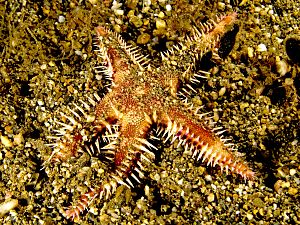Sand sifting starfish facts for kids
Quick facts for kids Astropecten polyacanthus |
|
|---|---|
 |
|
| Scientific classification | |
| Kingdom: | |
| Phylum: | |
| Subphylum: |
Eleutherozoa
|
| Class: | |
| Order: |
Paxillosida
|
| Family: |
Astropectinidae
|
| Genus: |
Astropecten
|
| Species: |
A. polyacanthus
|
| Binomial name | |
| Astropecten polyacanthus Müller and Troschel, 1842
|
|
| Synonyms | |
|
|
The sand sifting starfish, also known as the comb sea star, is a type of sea star. Its scientific name is Astropecten polyacanthus. This sea star belongs to the Astropectinidae family. It is the most common Astropecten species and lives across the Indo-Pacific ocean. Its arms can spread up to 20 centimeters (about 8 inches) wide. The name "polyacanthus" is Latin for "many thorned," which describes its spiky look.
Contents
What Does the Comb Star Look Like?
The top of the comb star is a dark purplish color. Its underside is bright orange. On its upper surface, it has small, pillar-like structures called paxillae. These paxillae have flat tops and can be cream, gray, or brown. Sometimes, their colors form a cool chevron pattern.
Along the edges of its five arms, you'll see a fringe of long, sharp spines. These spines usually have brown bases and pale tips. The arms are quite wide and can grow up to 9 centimeters (about 3.5 inches) long.
This starfish has special tube feet that are pointed, not like suckers. This design helps it dig easily through sand. The comb star can sometimes be confused with another sea star called Archaster spp.. They look similar because both have developed ways to dig in sand. However, Archaster has flat, blunt spines. It also has parallel rows of plates on its upper surface, which Astropecten polyacanthus does not.
Where Does the Comb Star Live?
The comb star lives in shallow tropical and sub-tropical seas. You can find it all over the Indo-Pacific region. This includes places from the Red Sea and Zanzibar to Hawaii. It also lives from Japan to Australia and New Zealand.
In Australia, its home stretches from Cape Naturaliste in the west. It goes all the way around the northern coast to Sydney in the east. This starfish often lives on soft, silty sand bottoms. You might find it in harbors and estuaries. It can live in waters as deep as about 185 meters (about 600 feet).
How Does the Comb Star Live and Eat?
The comb star spends a lot of its time buried in the sandy seabed. It is a very good digger! It eats detritus, which is tiny bits of dead plants and animals. It also eats small bivalve and gastropod molluscs. It swallows these whole.
Sometimes, it even swallows small pebbles. It then digests the thin layer of living material and tiny creatures stuck to the pebbles. This helps it get all the nutrients it needs.
Interestingly, Astropecten polyacanthus can contain a powerful natural substance called tetrodotoxin. This substance is a neurotoxin, which means it can affect nerves. Scientists have studied this to understand how it moves through the ocean's food chain. This starfish is mostly active at night.
Keeping Comb Stars in Aquariums
People sometimes keep the comb star in reef aquariums. It is very good at cleaning up the sand or gravel. It helps by eating detritus and any leftover food.
If you keep one, it needs to get used to its new tank slowly. It's important not to have too many comb stars in one tank. If there are too many, they might not find enough food and could starve.

